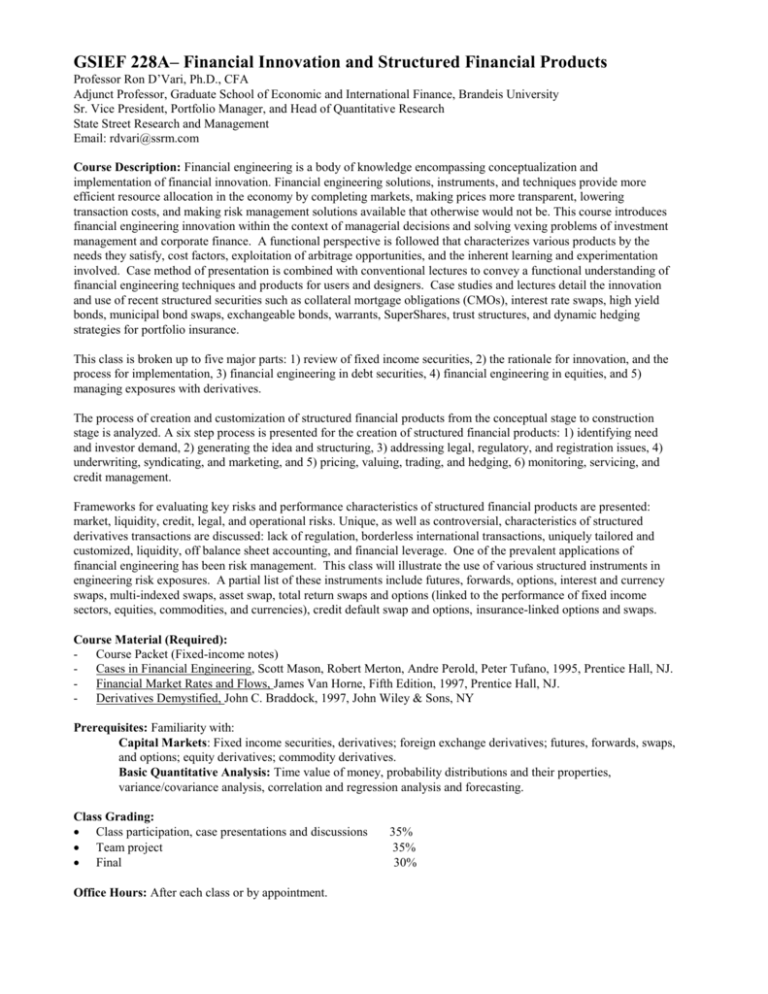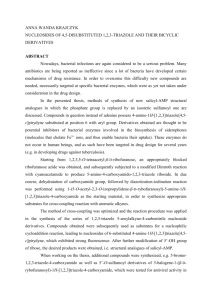Risk Management and Quantitative Methods
advertisement

GSIEF 228A– Financial Innovation and Structured Financial Products Professor Ron D’Vari, Ph.D., CFA Adjunct Professor, Graduate School of Economic and International Finance, Brandeis University Sr. Vice President, Portfolio Manager, and Head of Quantitative Research State Street Research and Management Email: rdvari@ssrm.com Course Description: Financial engineering is a body of knowledge encompassing conceptualization and implementation of financial innovation. Financial engineering solutions, instruments, and techniques provide more efficient resource allocation in the economy by completing markets, making prices more transparent, lowering transaction costs, and making risk management solutions available that otherwise would not be. This course introduces financial engineering innovation within the context of managerial decisions and solving vexing problems of investment management and corporate finance. A functional perspective is followed that characterizes various products by the needs they satisfy, cost factors, exploitation of arbitrage opportunities, and the inherent learning and experimentation involved. Case method of presentation is combined with conventional lectures to convey a functional understanding of financial engineering techniques and products for users and designers. Case studies and lectures detail the innovation and use of recent structured securities such as collateral mortgage obligations (CMOs), interest rate swaps, high yield bonds, municipal bond swaps, exchangeable bonds, warrants, SuperShares, trust structures, and dynamic hedging strategies for portfolio insurance. This class is broken up to five major parts: 1) review of fixed income securities, 2) the rationale for innovation, and the process for implementation, 3) financial engineering in debt securities, 4) financial engineering in equities, and 5) managing exposures with derivatives. The process of creation and customization of structured financial products from the conceptual stage to construction stage is analyzed. A six step process is presented for the creation of structured financial products: 1) identifying need and investor demand, 2) generating the idea and structuring, 3) addressing legal, regulatory, and registration issues, 4) underwriting, syndicating, and marketing, and 5) pricing, valuing, trading, and hedging, 6) monitoring, servicing, and credit management. Frameworks for evaluating key risks and performance characteristics of structured financial products are presented: market, liquidity, credit, legal, and operational risks. Unique, as well as controversial, characteristics of structured derivatives transactions are discussed: lack of regulation, borderless international transactions, uniquely tailored and customized, liquidity, off balance sheet accounting, and financial leverage. One of the prevalent applications of financial engineering has been risk management. This class will illustrate the use of various structured instruments in engineering risk exposures. A partial list of these instruments include futures, forwards, options, interest and currency swaps, multi-indexed swaps, asset swap, total return swaps and options (linked to the performance of fixed income sectors, equities, commodities, and currencies), credit default swap and options, insurance-linked options and swaps. Course Material (Required): - Course Packet (Fixed-income notes) - Cases in Financial Engineering, Scott Mason, Robert Merton, Andre Perold, Peter Tufano, 1995, Prentice Hall, NJ. - Financial Market Rates and Flows, James Van Horne, Fifth Edition, 1997, Prentice Hall, NJ. - Derivatives Demystified, John C. Braddock, 1997, John Wiley & Sons, NY Prerequisites: Familiarity with: Capital Markets: Fixed income securities, derivatives; foreign exchange derivatives; futures, forwards, swaps, and options; equity derivatives; commodity derivatives. Basic Quantitative Analysis: Time value of money, probability distributions and their properties, variance/covariance analysis, correlation and regression analysis and forecasting. Class Grading: Class participation, case presentations and discussions Team project Final Office Hours: After each class or by appointment. 35% 35% 30% List of Topics: Session 1: Introduction to Financial Engineering and Structured Finance PART 1: Review of Fixed Income Securities Session 2: Prices/Yield Relationship and Volatility Session 3: Term Structure of Interest Rates and Option Adjusted Sensitivity Measures Session 4: Structured Fixed-income Products: bonds with embedded options, mortgages, collateral mortgage securities (CMOs), and asset back securities PART 2: Process of Creation of Structured Financial Products and Some of Their Specifics Session 5: Six-Step Process to Creation and Maintenance of Structured Products Pricing, Valuing, Trading, and Hedging Structured Products Session 6: Specifics of Various Financial Products: Warrants; Index and Multi-index Asset Indexed Notes; Session 7: Specifics of Various Financial Products: Swaps, Equity Linked Notes; Investment Trusts Session 8: Specifics of Various Financial Products: Credit Derivatives PART 3: Cases in Financial Engineering in Debt Securities Session 9: Cases Motivated by Arbitrage: Stripping and Reconstruction, Arbitrage in Government Bond Market, Bonds with embedded option Session 10: Cases Motivated by Taxes, Regulation, and Accounting Session 11: Cases Motivated by Securitization and Lower Funding Costs PART 4: Cases in Financial Engineering in Equity Securities Session 12: Cases Addressing Information Asymmetries Session 13: Cases Motivated by Taxes, Regulation, and Accounting PART 5: Cases in Financial Engineering for Tailoring Risk Session 14: Cases Managing Issuers’ Exposures Session 15: Cases Managing Investors’ Exposures Class Requirements and Organization: Class sessions will start with a brief lecture and is followed by discussion of the readings and the assigned case studies. Students are expected to come prepared to class ready to discuss the readings and the case. All assigned cases are from Cases in Financial Engineering. Each team will be required to be prepared to open the discussions by highlighting the major issues in at least one or two cases. Other students will be asked to participate. It is required that each team to meet before the class and develop an outline of their arguments for each case. Team Project on a Financial Engineering Problem: The team project for the class is a paper on a selected financial engineering problem. Each team will research and select a specific current financial engineering problem related to innovative financing, securitization, profit monotization, risk transfer, tax reduction, or off-balance sheet accounting. Each team is required to prepare a detailed outline of the need and a proposed solution by week 6. Following approval by instructor, teams will devise and finalize a solution that meet the outlined need and detail out issues related to structuring, legal, regulatory, marketing, valuation/pricing, hedging, and operational, if applicable. Each team will be required to prepare a final project report and an in-class presentation by the last day of class. An interim progress report will also be required by week 12. Final Examination: There will be a take-home final examination covering all assigned readings and cases. Useful References: 1. Value at Risk (August 1996), by Philippe Jorion 2. Managing Financial Risk : A Guide to Derivative Products, Financial Engineering and Value (3rd edition, July 1998), by Charles W. Smithson and Clifford W. Smith 3. Derivatives Handbook (May 1997), by Robert Schwartz and Clifford W. Smith, Jr. 4. Swap & Derivative Financing : The Global Reference to Products, Pricing, Applications and Markets (Revised edition, August 1994), by Satyajit Das 5. Options, Futures, and Other Derivatives (3rd w/ disk edition, April 1997), by John C. Hull 6. Managing Credit Risk : The Next Great Financial Challenge (Wiley Frontiers in Finance), by John B. Caouette, Edward I. Altman, Paul Narayanan 7. Fixed Income Mathematics : Analytical & Statistical Techniques (October 1996), by Frank J. Fabozzi 8. Managing Bank Capital: Capital Allocation and Performance Measurement (August 1996), by Chris Matten (SBC) 9. Dynamic hedging (December 1996), by Nassim Taleb 10. CreditMetrics Technical Document - http://www.riskmetrics.com 11. RiskMetrics Technical Document - http://www.riskmetrics.com List of Topics: Session 1: Introduction to Financial Innovation and Structured Finance - Efficiency of financial markets and the role of financial intermediaries Types of financial innovation and their role The motives for financial engineering The dynamics of institutional change Financial engineering and the production process for financial intermediaries Implications for the future evolution of the financial system A historical and functional perspective of securities innovation Assignments Readings: Chapters 1 and 2, Cases in Financial Engineering, Scott Mason, Chapters 1 and 2, Derivatives Demystified, John C. Braddock, Chapters 1 and 3, Financial Market Rates and Flows, James Van Horne, Cases: None Team Project: - Form a project team - Initiate research to identify the nature and the source of a selected problem and associated need for a potential financial innovation or engineering approach. PART 1: Review of Fixed Income Securities Session 2: Prices/Yield Relationship and Volatility Foundations of interest rates Review of present value calculations Pricing and Yield Calculations for Bonds - Limitations of yield to maturity, yield to call, or yield to worst - Zero coupon bonds - Money market instruments Financial Engineering - The structured product creation, development, and offering process - Assignments Readings: Pages 87-116, Cases in Financial Engineering, Scott Mason, et. al. Chapters 3, Derivatives Demystified, John C. Braddock, Chapters 3 and 4, Financial Market Rates and Flows, James Van Horne, Cases: None Team Project: - Continue research to identify the nature and the source of a selected problem and associated need for a potential financial innovation or engineering approach. Session 3: Term Structure of Interest Rates and Option Adjusted Sensitivity Measures - - The relationship between yield and maturity Reasons for the normal slope of the yield curve (term structure); Implied forward curve Various term structure theories: pure expectation, term premium, and the market segmentation Basic characteristics of the Cox–Ingersoll–Ross single-factor term structure model and state how it differs from multi-factor and lattice-type models. Option-adjusted yield measures Assignments Readings: Chapters 6 -7, Financial Market Rates and Flows, James Van Horne, Cases: None Team Project: - Continue research to identify the nature and the source of a selected problem and associated need for a potential financial innovation or engineering approach. Session 4: Structured Fixed-income Products: bonds with embedded options, mortgages, collateral mortgage securities (CMOs), and asset back securities (ABS) - - Embedded options and option-adjusted spreads Mortgage securities and prepayment risk Mortgage derivatives ABS Structured Notes Collateralized Bond Obligation (CBO), and Collateralized Loan Obligation (CLO) Assignments Readings: Chapters 12 and 13, Financial Market Rates and Flows, James Van Horne, Cases: None Team Project: - Prepare and submit a detailed proposal for your team project. PART 2: Process of Creation of Structured Financial Products and Some of Their Specifics Session 5: Six Step Process to Creation and Maintenance of Structured Products Pricing, Valuing, Trading, and Hedging Structured Products - - Identify the investor demand The idea generation process and structuring process Legal and regulatory review and registration Underwriting, syndicating, and marketing Pricing, valuing, trading, hedging, and risk management Secondary market development and support -standardization Assignments Readings: Chapters 3 and 4, Derivatives Demystified, John C. Braddock, Cases: None Team Project: - Identify the investor demand and analyze it - Develop an outline of the basic issues and identify major areas that need to be researched. Session 6: Specifics of Various Financial Products: Warrants; Index- and Other Asset Linked Notes - - Warrants Exotic options Index-Linked Notes Other-asset Linked Notes Insurance-Linked Notes Assignments Readings: Chapters 5, 6, and 9, Derivatives Demystified, John C. Braddock, Cases: None Team Project: - Develop the basic idea and identify the basic features of the structure - Gather supporting data and conduct research addressing major issues. - Interview industry experts regarding specific issues Session 7: Specifics of Various Financial Products: Swaps, Equity Linked Notes; Investment Trusts - Swaps Swaptions Asset Swap Investment Trusts Trading Strategies and Capital Raising Approaches Assignments Readings: Chapters 10-15, Derivatives Demystified, John C. Braddock, Cases: None Team Project: - Identify and resolve significant legal issues of the product and regulatory review and registration Session 8: Specifics of Various Financial Products: Credit Derivatives, CBOs, CLOs, Insurance Linked Products - Credit Derivatives CBOs CLOs Insurance Linked Products Assignments Readings: Chapters 10-15, Derivatives Demystified, John C. Braddock, Cases: None Team Project: - Develop realistic underwriting, syndicating, and marketing plans







